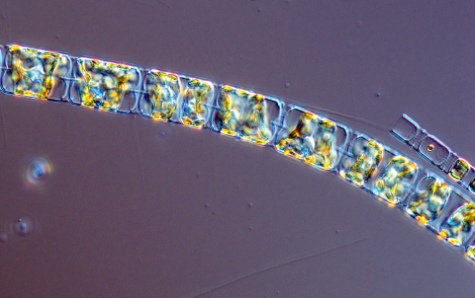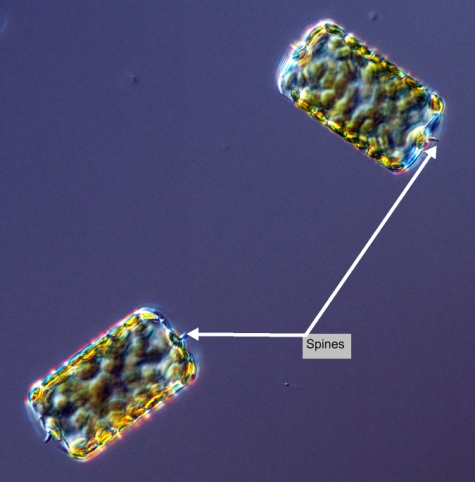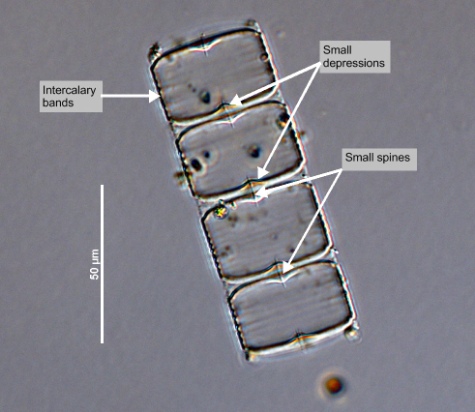



|
Synonym(s)
Schroederella delicatula (H. Péragallo) Pavillard 1913 Close
Heterotypic
A difference in type. In naming species, a heterotypic synonym is one that comes into being when a taxon becomes part of a different taxon. Compare to homotypic.
(heterotypic)Thalassiosira condensata Cleve 1900 (heterotypic)
Lauderia delicatula H. Péragallo 1888 (heterotypic)
Lauderia pumila Castracane 1886 Close
Basionym
The original name for an organism. In botany, the original published nomenclature from which a new binomial nomenclature is derived for a particular group of organisms (Tindall 1999).
(basionym, CloseHomotypic
Expressing the same fundamental type or structure; may or may not be symmetrical (e.g., the two valves of a diatom, where they are the same shape and appearance, but one is bigger than the other). In naming species, a homotypic synonym is one that comes into being when a taxon gets a new name (without being added to an already existing taxon).
homotypic)(Guiry and Guiry 2011, Guiry 2011)
Classification
(Guiry and Guiry 2011)
Lifestyle
Description
Valve
In diatoms, the structurally distinct halves of the cell wall (Becker 1996).
Valves are slightly convex with a depression in the centre, where a single distinct spine connects adjacent cells. Cells are also connected marginally by a ring of small spines, each of which splits off into two gelatinous threads joined to the spines of adjacent cell, forming a distinct zigzag pattern. Chloroplasts are numerous, small, star-shaped plates (Cupp 1943). Cell colour is yellow-brown (Guiry 2011).Radial
(symmetry) Describing a shape that many axes of symmetry. That is, it does not have a left and right like humans do (bilateral symmetry), but can be divided into equal halves no matter where you place the axis. Some examples of radially symmetrical organisms include sea stars and centric diatoms like Thalassiosira.
radial CloseRibs
Features that provide support to other structures in the cell.
ribs and a few well-developed CloseAreola(e)
In diatoms, the regularly repeated hexagonal holes on the valve walls (HPP 2003).
areolae. CloseGirdle bands
The connecting elements between two valves of a diatom cell. "They enclose and protect the cell and also accommodate the increase in cell volume during the cell cycle" (Horner 2002).
Girdle bands are numerous and collar-shaped with rows of areolae, forming incomplete loops. There are very small ClosePunctum
(plural: puncta) A sharp tip or small point on any part of an organism's anatomy.
puncta on the girdle bands (Horner 2002). Each valve has one marginal CloseLabiate process
In diatoms, a simple slit in the valve wall with two internal lips, one on each side of the slit. They can be useful in identification because they are positioned differently in different species (Horner 2002).
labiate process (Kraberg et al. 2010). Auxospores are elliptical, single, and lay in the girdle-band zone. They are much larger in diameter than the mother cell (Cupp 1943).Measurements
Pervalvar axis
The axis through the centre point of the two valves of a frustule. This axis is perpendicular to the valve face.
(pervalvar axis): 15 - 120 μmDiameter: 15 - 45 μm
Areolae on Close
Mantle
In diatoms, "the part of a valve that extends from the valve face, forming the valve edge." It is visible when the frustule is viewed in girdle view (Spaulding 2010).
mantle surface: 18 - 20 in 10 μmMarginal spines: 6 - 8 in 10 μm
(Cupp 1943, Hasle and Syvertsen 1997, Kraberg et al. 2010)
Similar species
Harmful effects
Habitat
Distribution
Cosmopolitan, may prefer warmer waters (Hasle and Syvetsen 1997).
Summer and autumn in Northern European seas (Kraberg et al. 2010). Late spring around Portugal (Gameiro et al. 2004, Silva et al. 2008).
"Fairly common off southern California and in Gulf of California" (Cupp 1943).
Growth conditions
Upwelling
A wind-driven mechanism of mixing the water column. Cold, dense, nutrient-rich, and often oxygen-poor water from depths rises to replace the warmer nutrient-poor surface water. This input of nutrients can have a significantly increase primary productivity in a region (Dugdale 1985).
upwelling events (Zúñiga 2011) and mixing of the CloseWater column
Referring to a water system from the surface to the bottom sediments. This can be used to understand processes of stratification, mixing and their relationship to nutrient transport. Temperature, salinity, pH, and nutrient levels often vary along the length of the water column.
water column (Cabeçadas et al. 1999). Salinity ranges from 16 - 35 (Gameiro et al. 2004)Environmental Ranges
Temperature range (°C): 2.387 - 29.386
Nitrate (μmol L-1): 0.061 - 11.093
Salinity: up to 36.252
Oxygen (mL L-1): 4.515 - 7.808
Phosphate (μmol L-1): 0.078 - 1.293
Close
Silicic acid
A general term to describe chemical compounds containing silicon, oxygen and hydrogen with a general formula of [SiOx(OH)4-2x]n. Diatoms polymerize silicic acid into biogenic silica to form their frustules (Azam and Chisholm 1976).
Silicate (μmol L-1): 0.754 - 25.562(OBIS 2011, cited in EOL 2011)
Bloom characteristics
References
Cabeçadas, L., Brogueira, M. J. and Cabeçadas, G. 1999. Phytoplankton spring bloom in the Tagus coastal waters: hydrological and chemical conditions. Aquatic Ecology. 33(3): 243-250.
Cai, W. G., Jia, X. P. and Li, C. H. 2004. GIS-based analysis of the spatial-temporal variation of phytoplankton in the Western Guangdong Waters. Shengtai Xuebao. 24(10): 2143-2148.
Cupp, E. E. 1943. Marine Plankton Diatoms of the West Coast of North America. University of California Press. Berkeley, California. 238.
Encyclopedia of Life (EOL). 2011. Detonula pumila (Castracane) Gran. http://www.eol.org/pages/897070. Accessed 14 Aug 2011.
Gameiro, C., Cartaxana, P., Cabrita, M. T. and Brotas, V. 2004. Variability in Chlorophyll and Phytoplankton Composition in an Estuarine System. Hydrobiologia. 525(1-3): 113-124.
Guiry, M. D. 2011. Detonula pumila (Castracane) Gran, 1900. http://www.marinespecies.org/aphia.php?p=taxdetails&id=149647. Accessed 14 Aug 2011.
Guiry, M. D. and Guiry, G.M. 2011. Detonula pumila (Castracane) Gran. http://www.algaebase.org/search/species/detail/?species_id=59627. Accessed 14 Aug 2011.
Hasle, G. R. and Syvertsen, E. E. 1997. Marine diatoms. In: Tomas, C. R. (ed.) Identifying marine Phytoplankton. Academic Press, Inc., San Diego. 5-385.
Horner, R. A. 2002. A Taxonomic Guide To Some Common Phytoplankton. Biopress Limited, Dorset Press, Dorchester, UK. 200.
Kraberg, A., Baumann, M. and Durselen, C. D. 2010. Coastal Phytoplankton: Photo Guide for Northern European Seas. Verlag Dr. Friedrich Pfeil, Munchen, Germany. 204.
Ocean Biogeographic Information System (OBIS). 2011. Detonula pumila. http://www.iobis.org/mapper/?taxon_id=620569. Accessed 14 Aug 2011.
Silva, A., Mendes, C. R., Palma, S. and Brotas, V. 2008. Short-time scale variation of phytoplankton succession in Lisbon bay (Portugal) as revealed by microscopy cell counts and HPLC pigment analysis. Estuarine, Coastal and Shelf Science. 79(2): 230-238.
Zúñiga, D., Alonso-Pérez, F., Castro, C. G., Arbones, B. and Figueiras, F. G. 2011. Seasonal contribution of living phytoplankton carbon to vertical fluxes in a coastal upwelling system (Ría de Vigo, NW Spain). Continental Shelf Research. 31(5): 414-424.
